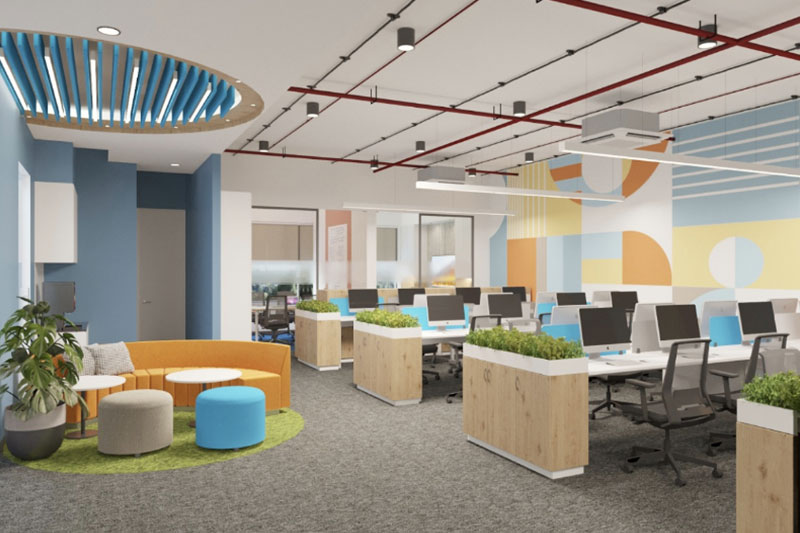
The Growing Demand for Human-Centric Lighting in Workspaces
Step into any modern office, and you’ll notice something different. Gone are the fluorescent lights that once flickered above desks. Instead, workplaces today are embracing lighting that doesn’t just illuminate but enhances productivity, well-being, and comfort. This shift isn’t just about aesthetics, it’s about creating an environment where people feel and perform their best. Welcome to the world of Human-Centric Lighting (HCL).
What is Human-Centric Lighting?
Human-Centric Lighting (HCL) is more than just a lighting upgrade, it’s a science-backed approach to enhancing workspace environments. It mimics the natural light cycle, adjusting color temperature and intensity throughout the day to align with the body’s circadian rhythms. Think of it like having a built-in sunrise and sunset indoors, designed to keep employees alert when they need to focus and relax when it’s time to wind down.
For businesses, this isn’t just a wellness trend, it’s a strategic move. Studies show that the right lighting can boost concentration, reduce fatigue, and even improve mood, directly impacting employee performance and satisfaction. In a world where companies compete to attract and retain top talent, lighting is no longer just about visibility, it’s about productivity and experience.
The Link Between Lighting and Productivity
Or overly alert under bright white light? That’s no coincidence. Lighting influences brain function, mood, and energy levels. Research suggests that exposure to cool white light in the morning can improve cognitive function, while warmer tones in the afternoon help prevent fatigue.
For businesses, this means lighting isn’t just an expense—it’s an investment. Companies are beginning to realize that a well-lit workspace leads to higher efficiency, fewer errors, and improved employee engagement. When people work in an environment tailored to their biological needs, they don’t just work better—they feel better.
From Static to Adaptive: The Shift in Workplace Design
Traditional office lighting used to be simple—one setting, one intensity, one size fits all. But workspaces have evolved. Hybrid work models, flexible seating, and wellness initiatives are reshaping office design, and lighting is following suit.
Adaptive lighting systems—which allow users to adjust brightness and color temperature—are becoming a must-have in modern offices. Imagine an open workspace where employees can personalize their own lighting settings or where meeting rooms automatically adjust to suit the type of discussion taking place. This is no longer a futuristic concept; it’s happening now.
Why Are Businesses Investing in Human-Centric Lighting?
Companies are beginning to recognize that lighting isn’t just about aesthetics, it has a direct impact on their bottom line. Investing in HCL brings several key benefits:
- Boosts Employee Productivity – Optimized lighting improves focus and reduces stress, helping employees perform at their best.
- Enhances Workplace Well-being – Reducing eye strain, headaches, and fatigue leads to a happier, healthier workforce.
- Increases Energy Efficiency – Many HCL systems use LED and smart technology, reducing electricity consumption and costs.
- Supports Brand Image – Businesses investing in employee wellness and sustainability are more attractive to clients and top talent.
Industry Adoption: Who’s Leading the Change?
While HCL is gaining traction across industries, some sectors are leading the way:
- Corporate Offices – Forward-thinking businesses are integrating smart lighting solutions to create more dynamic work environments.
- Coworking Spaces – Flexible workspaces are adopting HCL to cater to diverse work styles and needs.
- Healthcare & Education – These sectors understand the importance of biologically aligned lighting in enhancing focus and reducing fatigue.
- Manufacturing & Industrial Workplaces – Proper lighting reduces errors, accidents, and improves overall safety.
The Role of Smart Technology in HCL
With IoT-driven lighting solutions, businesses can now integrate lighting into their overall smart office ecosystems. AI-powered lighting systems adjust automatically based on natural daylight, occupancy, and user preferences. Some even sync with other office elements like HVAC systems and smart blinds, creating a seamless and energy-efficient environment.
For organizations looking to future-proof their spaces, investing in smart, human-centric lighting isn’t just an option, it’s a necessity.
What’s Next for Human-Centric Lighting?
The future of HCL is expanding beyond offices into hybrid workspaces, home offices, and commercial hubs. Companies focused on employee well-being, sustainability, and digital transformation are expected to lead the charge.
As businesses continue to rethink how spaces affect work performance, lighting will no longer be an afterthought it will be a key driver of success. Those who adapt to this shift will not only create better workplaces but also gain a competitive edge in the evolving business landscape.
If you’re looking to explore the latest advancements in lighting and design, ASEAN Light + Design Expo 2025 is the place to be. The event will take place at IMPACT Exhibition Centre, Bangkok, Thailand, from September 17 to 19, 2025. Make sure to visit and discover how lighting is shaping the future of workspaces.

 ไทย
ไทย
 中文
中文

